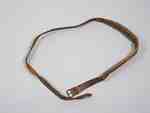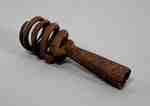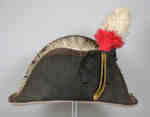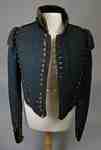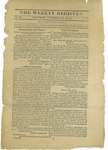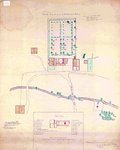Results
- This is the tip of a triangular bayonet that would have been designed to fit on the muzzle of a rifle or musket barrel, making it into a close range weapon. This would have been on arguably every solThis is the tip of a triangular bayonet that would have been …
- This linen bag features red stripes on a white background. The bag was used to carry flints for a flintlock musket. This type of bag was used from the Revolutionary War until 1820. Further research iThis linen bag features red stripes on a white background. The bag …
- This scabbard and belt, belonging to John Whitmore, features a buckle and was fashioned to hold a bayonet around the waist of a soldier. According to Niagara Historical Society Publication #8 "Mr. WhThis scabbard and belt, belonging to John Whitmore, features a buckle and …
- This triangular bayonet is dated circa 1810-1820 and has the distinctive markings “J. Hill, (Crown) 19” on the actual blade and “110 1 G DS” on the base. A bayonet is a steel blade that is designed tThis triangular bayonet is dated circa 1810-1820 and has the distinctive markings …
- This triangular bayonet is made of iron and would have been used on a musket. A bayonet is a blade that is designed to fit on the muzzle of a rifle or musket barrel, making it into a close range weapThis triangular bayonet is made of iron and would have been used …
- This iron shell hook is a spring or coil-like shape with a short handle. The length of the coil is 8.5 cm and the handle is 12.5 cm. It was used by the artillery to clean the barrels of cannons durinThis iron shell hook is a spring or coil-like shape with a …
- These flintlock pistols are made of silver and wood. The pistol features many designs, including an acorn, a rose, a lion, an anchor and a crown. One of the pistols is believed to have belonged to HeThese flintlock pistols are made of silver and wood. The pistol features …
- This is a black beaver felt hat with an ostrich feather, brass braids and bullion at its peaks. It also has a linen band trim, a black cockade and a double brass coin chain that run to buttons on theThis is a black beaver felt hat with an ostrich feather, brass …
- This is a wool and velvet coatee that is believed to be designed for a Glengarry Militia Officer, but the date of origin is unknown. It is a single breasted green coat with a velvet trimmed stand upThis is a wool and velvet coatee that is believed to be …
- This uniform coatee was worn by Colonel Daniel McDougal when he was an Ensign at the Battle of Lundy’s Lane on July 25, 1814. The design is for a Junior officer (ensign or lieutenant) of the VolunteeThis uniform coatee was worn by Colonel Daniel McDougal when he was …
- This plume with black feathers and a wooden base would have been placed on a soldier’s shako. It is believed to have belonged to Captain Martin McLellan who took part in the battle of Queenston HeighThis plume with black feathers and a wooden base would have been …
- This is the black tin box for Sir Isaac Brock’s hat (971.275.1A) that arrived from England after his death at the Battle of Queenston Heights. The box is shaped to fit the hat. During his funeral, inThis is the black tin box for Sir Isaac Brock’s hat (971.275.1A) …
- This gold braided epaulet, circa 1812, was worn as a decoration on part of a uniform. This epaulet is from the uniform of Captain Jacob A. Ball, who is believed to have been a Captain in the 1st LincThis gold braided epaulet, circa 1812, was worn as a decoration on …
- The Weekly Register, also known as Niles Weekly Register, was a weekly periodical edited by Hezekiah Niles (1777-1839) and published in Baltimore Maryland. Volumes of interest were published betweenThe Weekly Register, also known as Niles Weekly Register, was a weekly …
- A 1915 copy of Mr. President Russel's (president and acting administrator of Upper Canada from 1796-1799) estate plan in 1797. It illustrates the house and garden plans of his estate including site dA 1915 copy of Mr. President Russel's (president and acting administrator of …
- This document is a printed form of a Muster Roll of a Company of Infantry under the command of Captain Hugh R. Martin in the 13th Regiment of the United States, commanded by Col. P.P. Schuyler from 3This document is a printed form of a Muster Roll of a …
- A handwritten map of Laura Secord’s route from Queenston to Beaverdams during the War of 1812. There is also a short history of the map itself included. It is black ink on three pieces of cream paperA handwritten map of Laura Secord’s route from Queenston to Beaverdams during …
- A letter from John Clark at Fort George to Major Ten Broeck of the 4th Lincoln Militia, which states that there is an accompanying letter with the Militia D Order. This is 3 weeks before the Battle oA letter from John Clark at Fort George to Major Ten Broeck …
- This is a muster roll, dated June 4th, 1810, for George Lawrence's Company of the 1st Regiment Militia for the County of Lincoln. Names included are: Captain George Lawrence, Lieutenant John Servos,This is a muster roll, dated June 4th, 1810, for George Lawrence's …
- This is the payroll for Captain Servos’ Company of the Lincoln Militia for their services at Fort George in 1814. The names included are: Jacob Lutz, Abram Scott, William Secord, Abraham Collard, SteThis is the payroll for Captain Servos’ Company of the Lincoln Militia …








